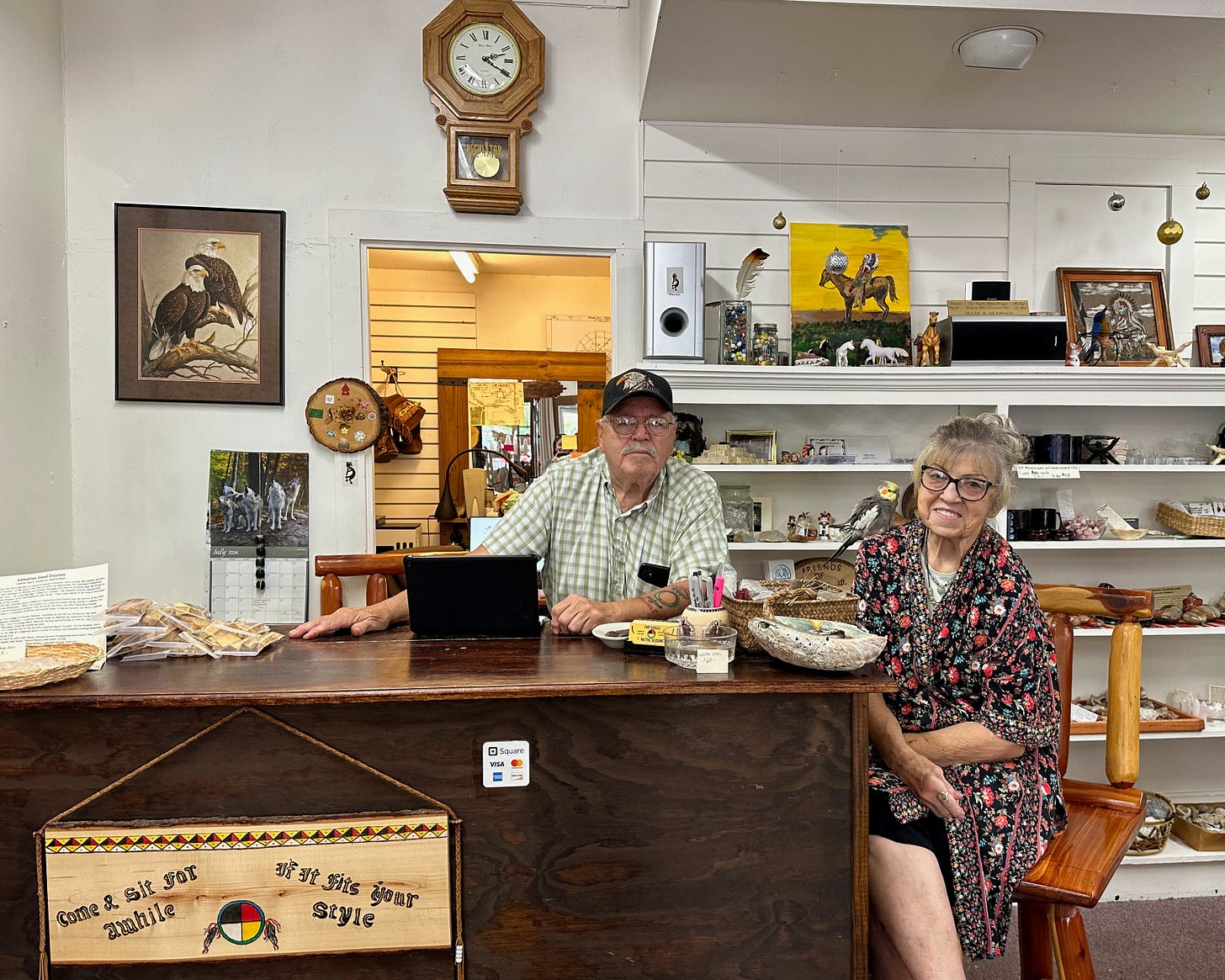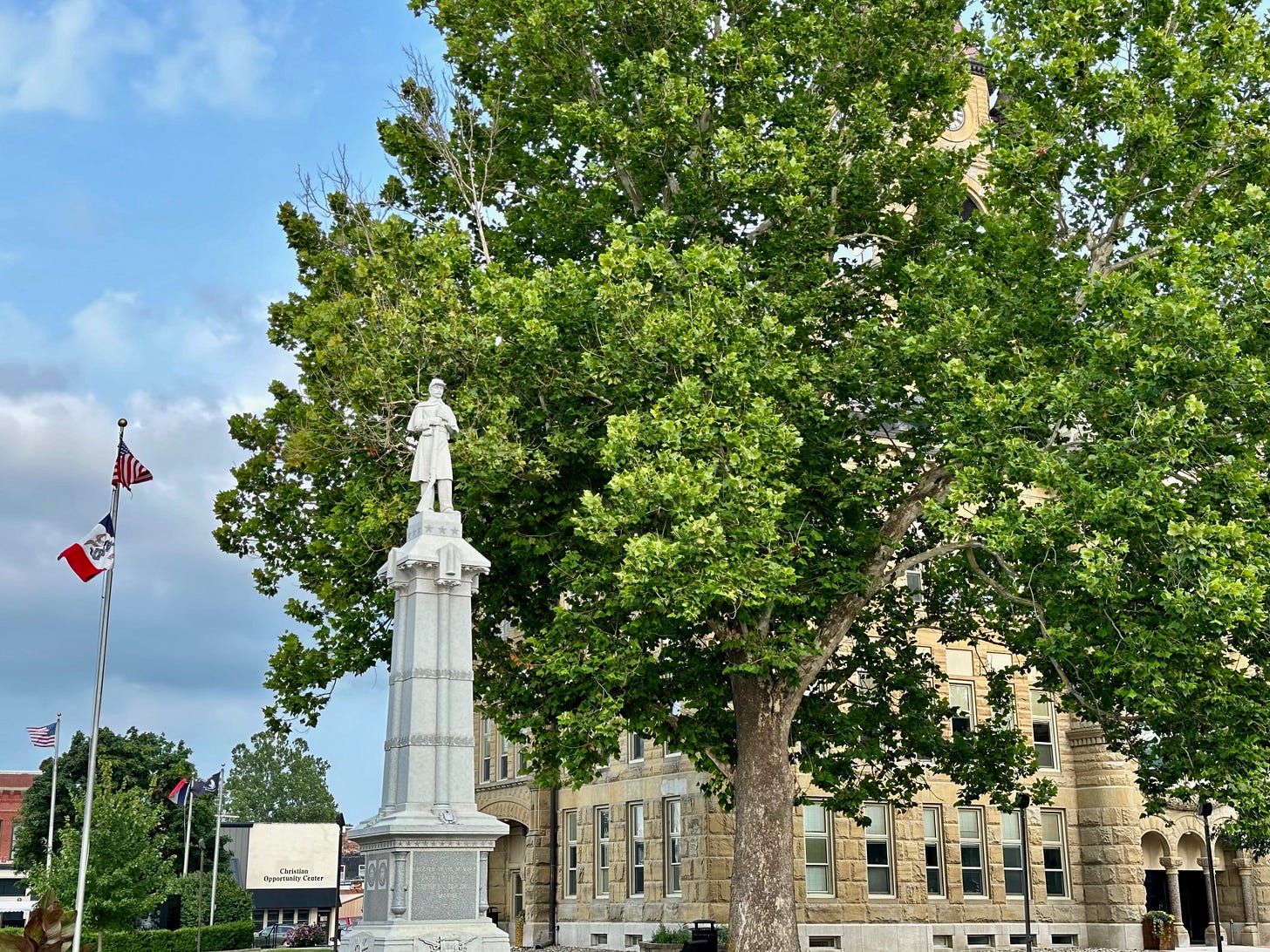RAGBRAI After the Caucuses. Biking across a Red State in an Election Year (Part 4)
What happens when people vote against their interests? Town to town, it's evident in Iowa
We are pausing our regularly scheduled programming for a special election essay. In addition to voting, after canvassing the state of Iowa in July 2024 for the (Des Moines) Register’s Great Bicycle Ride Across Iowa (RAGBRAI), I penned a 10,000-word essay on the reasons a vote for Trump is a vote against American and international interests, as I saw it across Iowa.
Day 6, Ottumwa to Mount Pleasant: Patriotism and Healthcare
One of the qualities most associated with Americans is their patriotism, and Iowa is no doubt a patriotic and religious state, much of Christian. The Roman Catholic and the Methodist Episcopal churches both organized congregations in Iowa by 1834, and by 1836 both denominations had constructed church buildings in Dubuque or founded missions along the Mississippi River. As the 19th century passed, other religious groups had towering church steeples over the farm towns surrounding them, including the Community of True Inspiration in the Amana Colonies, the Dutch Reformed Church in Pella — a Netherlandish town in the center of the State — and the Amish. During the Civil War many churches split between northern and southern groups, even though the African Methodist Episcopal Church, founded by former slaves, was informally set up in Iowa before then. And almost all of them believed in taking up arms to defend their god and their country.
So when a man named “Bubba” began slathering paint in patriotic and military themes on massive boulders wherever he could find them — outside of towns, in town squares, on townsfolk lawns — practically everyone in the state got on board. Ray “Bubba” Sorenson got his inspiration after watching the 1999 Stephen Spielberg movie Saving Private Ryan as a 19-year-old freshman at Iowa State University. The following day, the first “Freedom Rock” made its appearance along Interstate 80. For the next 20 years, Sorenson led an ambitious quest to varnish a rock dedicated to veterans in all ninety-nine Iowa counties, calling it the ”Freedom Rock Tour.” Occasionally, there has been a race among American Legions and city councils to claim their massive ninety-ton tributes, but every now and again country supervisors find that three veterans' memorials in the shadow of the courthouses is plenty — that they don’t need a Freedom Rock — and debates occasionally erupted. Sorenson stayed out of all them, focusing instead on “the guy that worked down at the hardware store that you never knew that earned a Silver Star in Korea,” he said. Sorenson even, at one time, blended the ashes of deceased veterans into his paint — his original rock contains the ashes of nearly 100 Vietnam servicemen. But since 2018, Bubba has not had much time to focus on his rocks — or his mural painting business, Sorenson Studios — since parlaying his mission into a career as a member of the Iowa House of Representatives, serving as chair of the House Economic Growth Committee and the vice chair of the House Appropriations Committee, which oversees the funding for all of Iowa’s public programs, including money for veterans. And Iowa’s 158,976 veterans, about six percent of its population, are some of the most well supported people in the state.
In 2022, a veteran who served in the Vietnam War — the majority of the veterans in Iowa who are still alive — earned an estimated salary of forty-five thousand dollars per year and were offered such things as five-thousand-dollar grants for buying homes in Iowa, a military retirement exemption from Iowa income tax, and various other discounts, such as hunting and fishing licenses and property taxes. Iowa vets also have some of the best health care in the state. The Department of Veterans Affairs gave its two Iowa hospital systems three out of five stars overall, but the VA Central Iowa Hospital scored five stars, along with a five-star patient survey rating for veteran treatment for such conditions as cancer, diabetes, and mental health. In fact, the VA hospitals scored better than most of the other hospital systems in Iowa, including the ones operated by its universities. Moreover, while the VA receive additional funding to upgrade their medical centers, Iowa has lost more than two-hundred-fifty health care facilities in the last fifteen years, according to a report from Common Sense Institute Iowa. Iowa also has a shortage of physicians — 5,778 practicing doctors down from just 5,900 — especially in rural areas, ranking forty-fifth out of fifty states in terms of the patient to physician ratio. These include doctors for aging Baby-Boomers, as well as OBGYNs to take care of new mothers.
And while Iowa struggles to find doctors and nurses, the rates of such illnesses as invasive cancer, Parkinson’s and Alzheimer’s keep increasing. A 2023 report found that Iowa has the second highest rate of new cancers in the U.S., while the 2024 report found a common cancer risk factor among Iowans: alcohol. Iowa has the fourth highest incidence of alcohol-related cancers in the U.S., and the highest rate in the Midwest. Still an estimated 21,000 new, invasive cancers — cancers diagnosed as stages one to four — led by breast, prostate, and lung, will lead to the death of 6,100 Iowans in the coming year, while an estimated 168,610 people will survive. Another reason more and more Iowans are contracting cancer: twenty years of unregulated farming practices. Between pesticide use, nitrate from animal waste, obesity, and radon exposure from working in soil with uranium deposits, two in five Iowa residents, including children, will develop lung, pancreatic, and colon cancer, as well as leukemia. But a final factor contributes to all the cancer in Iowa: silence. Talking about pesticides, nitrates, radon and CAFOs are a “taboo subject” in the agricultural state. “People know what to do. We know what to do and that’s to regulate the pollution from agriculture, but it’s such a taboo subject that it’s hard to get anybody to talk, especially if they’re still working,” said Chris Jones, a retired research engineer and chemist at the University of Iowa. Another concerned Iowan, Neil Hamilton, former director of the Drake Agricultural Law Center, told England’s DailyMail that “there seems to be a surprising lack of curiosity [from] the agricultural companies and agriculturalists and farm groups … And, you know, maybe that’s predictable, because they maybe are concerned about what might be found if we started scratching a little bit deeper.” Still, with thirty million acres of land in Iowa in farming out of thirty five million, the land remains held hostage by a select few.
So does the state’s largest collective fundraiser. RAGBRAI Ride Director Matt Phippen has said he gets countless requests from cancer charities and nonprofit organizations to partner with the ride. But RAGBRAI has two beneficiaries: RAGBRAI Gives Back, which will donate about $5,000 to each of this year’s thirty-two pass-through towns, $10,000 to the seven meeting towns, and $15,000 to eight overnight towns; and the Dream Team, a program that trains underprivileged youth to ride on the cross-state trek. For the first time in 2023, however, RAGBRAI formed an entity with GoFundMe to allow riders to set up individual fundraising pages for specific causes. That policy might need to change. Like many of the counties in Iowa, the health services from Ottumwa to Mount Pleasant are run by Great River Health — a for-profit system of hospitals, clinics, pharmacies and care facilities — that, in September, started following a “provider-based” billing model for outpatient services. That means patients will receive two separate bills: one for the health care provider/professional services and a line item charge for the facility/hospital charges, including room usage, equipment, supplies, and any additional healthcare staff involved during someone’s visit or procedure. All of this, said one spokesperson “helps ensure the long-term sustainability of healthcare services in our region by meeting the financial demands of providing care.”

Day 7, Mt. Pleasant to Burlington: Religion and Racism
While my father has never supported any charity while doing RAGBRAI, he has always been a supporter of — and has likely donated a large amount of his wealth to — Catholic causes. Born in Sacred Heart Hospital in Fort Madison, Iowa, educated at St. James Catholic school, enrolled in seminary at St. Ambrose College in Davenport before serving in the Vietnam War and deciding that priest life was not for him, Dad nonetheless has attended mass every Sunday, if not every day, for nearly eighty years. Catholicism is in his blood; it runs deep within him. To see him try to prevent the decimation of all of the Catholic institutions in Iowa has, at points, been like witnessing ghost-limb syndrome.
One of the first white men to see Iowa was a priest: the French Jesuit Father Marquette, who landed near Montrose, in Lee County, where he made first contact with the Native Americans. In 1788, Julien Dubuque, a French Canadian trader, obtained from them a grant of land, which they mined for lead, while forming Iowa’s first town: Dubuque, which is also the site of the first Catholic church built by a Dominican missionary in 1836. Seven years later, the Sisters of Charity of the Blessed Virgin Mary left Philadelphia for Iowa, as did Trappist monks from Mount Melleray, Ireland. By 1858, Iowa had forty-eight priests, sixty churches and a Catholic population of fifty-four thousand people; fifty years later, those numbers had increased five-fold with all the German immigrants. At the turn of the 20th century, the Sisters of Mercy established hospitals across Iowa, then built Mercy Medical Center in Des Moines with a nursing school adjoining. Competing orders founded more hospitals and more schools until the mid-1950s. In fact, Catholic nuns and priests educated twelve percent of all schoolchildren in the U.S. Most Catholics back then allied themselves with the Democratic party.

But since 1965, the ranks of nuns has declined by sixty-two percent, and the staff composition of Catholic schools went either lay or the schools closed their doors. “The school system had literally been built on (the nuns’) backs,” as written in the 1992 study Catholic Schools and the Common Good, “through the services they contributed in the form of the very low salaries that they accepted.” Despite a growing Catholic citizenry (from forty-five million in 1965 to almost seventy-seven million today — now the largest Christian denomination in the U.S.) Catholic school enrollment has plummeted, from five million students in nearly thirteen thousand schools in 1960 to two million in seven thousand schools by 2006. Meanwhile, Iowa has attempted to turn the tide with the Students First bill, which grants of up to $8,000 per year for parents in to use for private school tuition and fees and other educational expenses. The state, in turn, gives $1,000 per student to public schools on behalf of each student who uses the money for private school.
But is private Catholic school really better? Research suggests that Catholic schools in the U.S. have higher academic achievement than public schools, and some say they have a positive impact on the communities they serve. In the U.S., graduates of Catholic high schools are more likely to vote; achieve higher levels of earning potential; and have parents that tend to take a more active role in their student’s education. Studies also suggest that the achievement gap between students of different racial and economic backgrounds is significantly smaller within Catholic school communities — more than nineteen percent of roughly two million students enrolled in Catholic schools represent minority communities. Furthermore, the percentage of Catholic school students who will go on to attend a four-year college or university is estimated to be as high as eighty-five percent. Similarly, Catholic school students have been shown to consistently achieve improved math scores between their sophomore and senior years, as well as achieve higher academic achievement compared to their public school counterparts.
Other statistics say that private school students are more likely to experience bullying than their state-educated peers, a UK educational think tank reported. “In the wider population we often assume that a private education will have a very positive impact on a child’s development, when in reality many of its benefits result from the legacy of a privileged family background,” said Professor Sophie von Stumm, the lead author of the study, which is based on data from the Twins Early Development Study, a sample of twins born between 1994 and 1996. While private school students are less likely to have behavioural problems, a new study has found that they are fifteen per cent more likely to experience bullying during secondary school and twenty-four per cent more likely to take risks.
Anecdotally,some of the Catholic schools in Iowa follow these narratives.
Parochial education is a key staple of my family schooling. All of my aunt and uncles, many of my cousins, and many of my cousins attended Catholic institutions. When my cousin and his wife were unable to conceive, they adopted two children — one white and one biracial — and sent them to the best Catholic school in Cedar Rapids: Xavier. Xavier, a model diocesan school, receives a significant amount of money and resources, including — just last year — an architectural, construction and engineering program and building for its students. The Xavier Falcons are repeatedly at the top of the Friday Night Light football game schedule.
Both of my cousins became good athletes, the biracial one, in particular. When he had a chance to try out for school running back, his competition was a white student, a boy whose father was well-connected in the diocese. One day, my cousin opened his email to find a copy of the now infamous photo of a Minneapolis police officer killing George Floyd. Instead of George Floyd, however, my cousin’s face was photoshopped on top of George Floyd’s. The hate crime didn’t make the local newspapers or even, the local PTA meeting. My cousin’s teenager left the football team and rarely came out of his bedroom for the next year. My aunt — his grandmother — a good-hearted, generous, thoughtful Catholic woman asked us not to repeat the story. “It’s a good school with good people and I know they tried their best to make up for it.” I left out names in deference to her.
Perceived racial discrimination (PRD) is a risk factor for a wide range of undesired health outcomes across populations, particularly racial and ethnic minorities Among Black youth, PRD increases risk of mental health problems such as psychological distress, suicidal ideation, as well as psychiatric disorders, such as anxiety, and depression, according to National Institutes of Health. Moreover, males seem to be more vulnerable to the mental health effects of discrimination. In a six- and twelve-year follow up study of Black youth in Flint, MI, an increase in racial discrimination predicted worsening of anxiety and depression symptoms for male Black youth.










